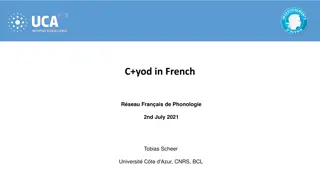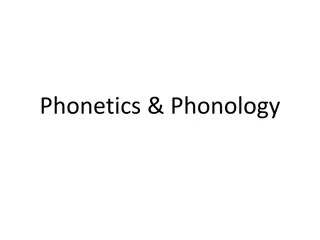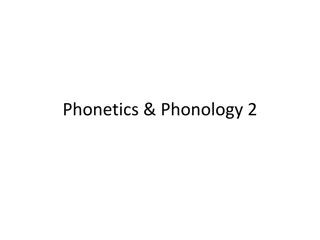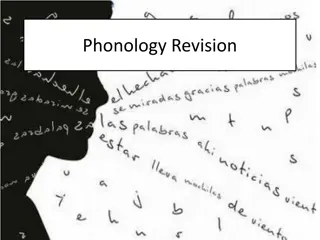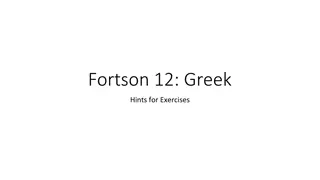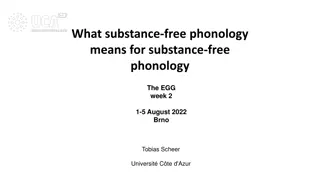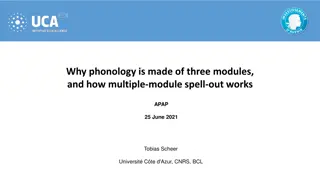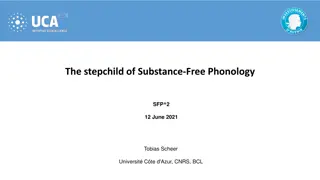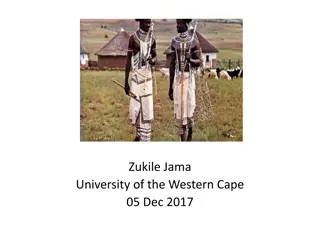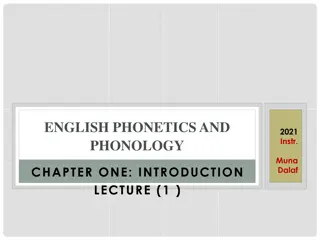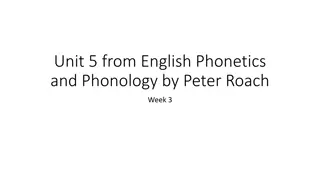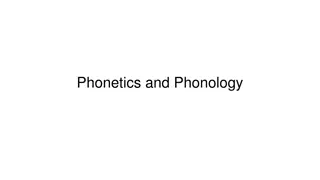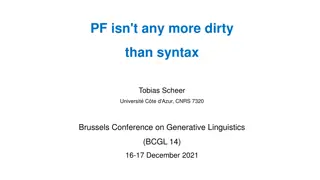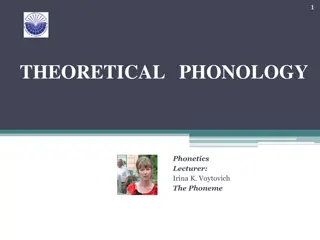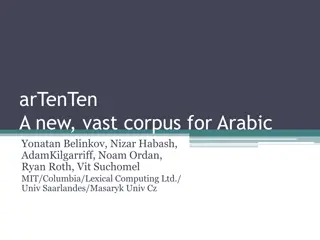Exploring Bantu Phonology and Linguistic Classification
Delve into the intriguing world of Bantu phonology and linguistic classification, covering the diverse sounds and phonological processes found in Bantu languages. Discover the rich heritage of over 500 Bantu languages in sub-Saharan Africa, classified into zones and classes, shedding light on the fascinating interplay of sounds that form the basis of this linguistic group.
Download Presentation

Please find below an Image/Link to download the presentation.
The content on the website is provided AS IS for your information and personal use only. It may not be sold, licensed, or shared on other websites without obtaining consent from the author. Download presentation by click this link. If you encounter any issues during the download, it is possible that the publisher has removed the file from their server.
E N D
Presentation Transcript
BANTU PHONOLOGY A brief overview of sounds and sound systems that one expects to encounter in Bantu languages.
OBJECTIVES To create awareness of the sounds and phonological processes that one expects to find in Bantu languages To lay a foundation on which to carry out research/project
MOTIVATION To bias us to consider researching on Bantu languages now and in the future To arouse linguistic curiosity about Bantu languages Curiosity-language is intriguing( I think it should be to linguists)- a pool of a limited number of sounds combine(phonology) to form all the languages of the world- amazing!!) Bantu languages remain largely under-described
Off we go What is phonology? Let s remind ourselves
LINGUISTIC FACTS ON BANTU LANGUAGES Around (question of dialect and language)500 of them found in sub-Saharan Africa-from Nigeria to Somalia to southern tip of the continent Question of dialect and language e.g. Kimeru language in the current Guthrie classification? What we have are dialects of Kimeru The name was given to these languages by a German linguist; Wilhelm Heinrich Immanuel Bleek (1827-1875). The name( Bantu) means mankind. It was coined from ba-a plural prefix +ntu-meaning man or person.
EXERCISE 1 Bantu speaking participants can give us the name for person in their native language eg. Gichuka- muntu Gikuyu-Mundu etc Gusii etc. Note:in Central Kenya bantu mu-a is a prefix for class 1 nouns Sing/Plu antu, andu
Guthries(1967-71) Classification of Bantu languages Updated version( Maho, 2009) Divided the region where the languages occur into zones The zones generated sixteen classes- using letters A S based on geographical regions Individual languages were assigned unit nos.eg. A12,17,20 etc. Dialects were further sub-divided.
Description The 250 or so "Narrow Bantu languages" are conventionally divided up into geographic zones first proposed by Malcolm Guthrie. These were assigned letters A S and divided into decades; individual languages were assigned unit numbers, and dialects further subdivided. Linguistic classification: Niger Congo > Atlantic Congo > Benue Congo > Southern Bantoid > Bantu Geographic distribution: Africa, from approximately the equator south Subdivisions: Zones A S (geographic)
Exercise 2 Where is Kenya in the map of Africa? In which region of Kenya are we in? What is the letter denoting this zone?
THE VOWEL SYSTEM OF BANTU LANGUAGES Proto Bantu is assigned 7 vowels with contrastive vowel length. Most Bantu languages have a five vowel system or a seven vowel system. (Few have more , also a few have nasalized vowels). The five vowel system e.g. Kiswahili (i , , a, , u) Seven vowel system e.g. All the bantu languages in central Kenya/i, e, ,a , o, , u/ NB: Need for appropriate machines to place them precisely on the Vowel trapezium /
GCHUKA VOWEL SYSTEM High ii: uu ee: oo: Mid : : Low aa:
Short Vowels 1. /i/ - / keriko / cookingstove 2. /e/ - /andeka / write 3. / / - / t n / in the past 4. / a / - / ona / see 5. /o/ - / roga / jump 6. / / - / a / 7. /u/ - / ruga / tie cook
Long Vowels as in / i:mba./ 1. /i / dead bodies 2. /e: / as in / e:ria / thatone 3. / : / as in / l : ta / bring 4. / a: / as in / b a:ria / there 5. / :/ as in / nt : / smoke 6. /o: / as in /nto:ra / village 7. /u: / us in /mu:ro / heatwave
VOCALIC PROCESSES Vowel harmony Gliding Compensatory lengthening-among others
VOWEL HARMONY Harmony refers to the assimilation of vowel sounds that are similar to each other in a domain e.g. (most common being Vowel Height harmony-VHH)i.e. Vowel height on the trapezium(3 or 4 degrees) (Backness and rounding can also be factors in vowel harmony) Found in Verb affixes-the applicative, separative, agentive,causative(VHH)-Bantu phonology is highly sensitive to morphological considerations.
DEFINITION OF VOWEL HARMONY According to Hyman (1999), vowel height harmonising is found in many Bantu languages. It is also found in Gichuka. Vowel height harmony in Gichuka is a lowering process of high vowels that are preceded by mid -vowels in the root. In the applicative suffix, the vowel ~e~ is lowered to/ /only before the mid-vowels { , } while in the separative suffix, the vowel ~ o ~ is lowered to / / only following an / /
APPLICATIVE IN GICHUKA (1) Verb Gloss Applicative Suffix Gloss a) R ma / rema / weed r m- ra-/remera / weedfor b) Ringa /ringa / beat ring- r-a /ringera / beatfor c) ruga /ruga / rug- r-a / rugera / cookfor cook d) r g a /roga / r g- r-a / rogera / jumpfor jump e) Taara / ta:ra taar- r-a/ taarera / selectfor select f) Reeta /r :ta / rete-er-a / r t ra / bringfor bring g) Oba / a / o -er-a / ra / tiefor tie
SEPARATIVE IN GICHUKA (2) Verb Gloss Separative Suffix Gloss a) kara / ekara / sit kar- k-a / ekaroka / stand b) Binga / inga / close Bing- r-a / ingora / open c) Curia / curia / hang chur -ki-a / curokia / unhang d) K nja / konja / fold k nj- r-a / konjora / unfold e) Maka / maka / besad Mak- k-a / makoka / stop being sad f) Tega /t ga / put on fire Teg- r-a / t gora / remove from fire g) Oba/ a / tie Ob-or-a / ra / untie
EXPLANATION Gichuka vowel harmony process can therefore be explained by saying that the data in (1a-e) show no harmonisation of the applicative suffix, while (1f) and (1g) do. The data in (2) shows that only the mid vowel / / triggers harmony. Suffixes with /a / show no vowel harmony (1e and 2e). The vowel harmony is asymmetric because in the case of suffixes containing / u /, the mid vowel / / fails to trigger the process (2f).
Exercise 3 Kiswahili Vowel Harmony(Applicative) Gloss a) Fanya-fanyia b) Pika - pikia c) Ruka - rukia d) Shona -shonea e) Leta - letea Study the data and summarize the vowel harmony that is found in Kiswahili A native speaker to give us another set of data for comparison e.g. Gusii do for cook for jump for sew for bring for
Gliding Usually the gliding of u/o and i/e into w and y respectively For example: Kikuyu(agentive) Mo+aka - mwaki Mo+endia - mwendia Mo+adeka - mwandeki Mo+atura - mwaturi Gloss builder buyer writer cutter
COMPENSATORY LENGHTHENING The lengthening of a vowel sound upon the loss of a following consonant usually in the syllable coda. It can also be triggered by the loss of a vowel in an adjacent syllable Bonface to provide Gusii data: /e -emba/ /e jeemba/ emi-osi/ /emujuusi/
THE CONSONANT SYSTEM General Remarks Most Bantu languages are reported to have two sets of plosives, voiced and voiceless Most of them have a full set of nasals at each place of articulation where a stop or an affricate appears Most of them have a relatively limited set of fricatives They often have one liquid but some have two e.g Gitigania Approximants occur in Bantu languages(j,w) often alternating with high vowels(I,u) Look out for the consonant Clusters
CONSONANT PHONOLOGY Consonant Clusters Dahl s law
CONSONANT CLUSTERS They are of two types -a nasal + a homorganic stop e.g mp,mb,nt,nk(commonly referred to as NC clusters) -a nasal +a glide(NG) NB: They can vary greatly from language to language be on the lookout for them
DAHLS LAW Voiceless stops become voiced if the consonant in the next syllable is also voiced The process has taken place in Kikuyu as shown below: Gloss -/ke + kena/ /gekeno/ -ke+tea/ /gutea/ respect -/ke +toma/ /gitumi/ Some languages have not undergone the process and there violations so the need to look at each language individually. happiness reason
Gichuka Consonants EXAMPLE: G CHUKA CONSONANT SYSTEM Bilabi Dental Alveolar Palatal Velar al Plosives b t (d) c ( ) k (g) Trill r Fricative Semi Vowel (w) (j) Nasal m n
plosives /b/ - voiceless bilabial stop / ba / /t/ - voiceless alveolar stop / ata / /d/ - voiced alveolar stop- / mogonda / farm/garden /c/ - voiceless palatal stop /oca / / / - voiced palatal stop - /n oke / /k/ - voiceless velar stop / ka io / /g/ - voiced velar stop / aka / give sweep pick bee knife this one
Fricatives and Nasals / / - voiced bilabial fricative - / a a / / / - voiced dental fricative - / ma / / / - voiceless velar fricative - / nt / father read smoke / m / - bilabial nasal / mami / / n / - alveolar nasal / ona / / / - palatal nasal / ua / / / velar nasal mother see drink / mbe / cow
NC Clusters Nasal Consonant Point of Homorganic Phonetic Example Gloss Nasal Assimilation Symbol mb nd nj nt nc nth Bilabial Alveolar Alveolar Alveolar Palatal Dental mbori ndeke njoka ntaka ncera nthaka goat aeroplane snake mud Jail circumcised young man / m b / / n d / / n j / / n t / /n c / / n / rw nk ng bilabial Velar Velar rw g nk nia nguo hawk gunny bag clothes /rw/ / n k / / n g / nw bilabial nwabo Still there /nw/
Semi-Vowels and Trills / w / - bilabial semi-vowel / waku/ yours / j / - palatal semi-vowel / mb ja / dry maize stalk / r / - alveolar trill rima dig
OTHER PROCESSES NB: There are other processes such as Bantu spirantization, aspiration, palatalization, nasal harmony, nasalization and others that we need to be on the look out for. I have only looked at those which are commonly attested.
SYLLABIFICATION IN BANTU Bantu syllable structure is open Summary(N)CV,NV,V) Unresolved issues on Bantu syllabification include : -syllabic status of consonant clusters -resolution of vowel hiatus
Exercise 4 Generate words from Bantu words in pairs/groups and identify the syllables e.g muntu, mwari, ino,etc
BANTU ORTHOGRAHY Orthography- the way a language is written It is a wide topic because of the no. of languages A look at Gichuka orthography will help us transcribe Central Kenya Bantu languages For an in depth study refer to the Bantu Orthography Manual (2010) by Leila Schroeder published by SIL international.
GICHUKA CONSONANTS Phonetic symbol / / - / / / /- / /- / / Orthography ny b- g - j- ng- Example ny mba a a g k nj k ng ombe Gloss house father here bee cow
VOWEL ORTHOGRAPHY Phonetic Symbol /i / /e / / / / a / /o / / / /u / Orthography i e a o u Example indo k riko tene gaka r ga ona ruga charcoal stove in the past this one jump see cook Gloss things
CLOSING REMARKS The nature of Bantu languages is such that phonological processes are influenced by morphological processes especially noun classes as we look at morphology later. It will become clearer. Area not looked at-phonotactics of Bantu Languages THANK YOU.












